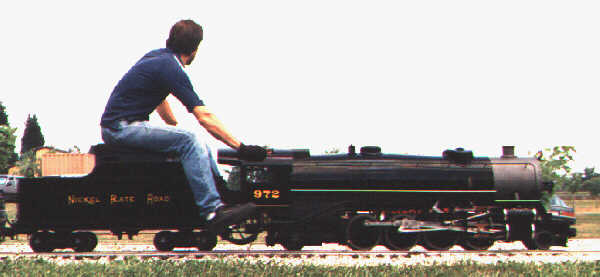Mikado 2-8-2 were originally named in 1897 after a group was built for Nippon Railway
of Japan. The name means "Emperor of Japan", the 1885 opening of Gilbert
& Sullivan's opera "The Mikado" had brought the name into use. During
the 1900-1920 years the Mikado became the standard freight locomotive. The 625 light
USRA version out numbered all other USRA road engines combined. During W.W.II
several railroads tried to rename them to MacArthurs however the Mikado name has stuck.
Locomotive Information
Engine Type: 2-8-2 Mikado
Engine No.
Road Name:
Owner: Tom Dolan
Builder:
Year Built or Finished:
Scratch Built or Kit:
If kit Manufacture:
Specs:
Track Gauge: 4 3/4" 1" Scale
Length of Engine:
Length of Tender:
Weight:
Fuel:
Driver Dia.
Cylinder Bore and Stroke:
Working Pressure:
Comments: (History, time to build, previous owners, comments on
original locomotive)

Locomotive Information
Engine Type: 2-8-2 USRA Heavy Mikado
Engine No. 972
Road Name: Nickel Plate Road
Owner: Larry Kirchner
Builder: Larry Kirchner
Year Built or Finished: Completed 1993
Scratch Built or Kit: Kit
If kit Manufacture: Railroad Supply (now Darby's Railroad
Supply)
Specs:
Track Gauge: 7 1/2" 1.6" Scale
Length of Engine: 82 1/2"
Length of Tender: 53"
Weight: Engine 1390lbs
Tender 400lbs
Fuel: Soft Coal
Driver Dia. 8 3/8"
Cylinder Bore and Stroke: 2 1/2" x 4"
Working Pressure: 125psi
Comments: (History, time to build, previous owners, comments on
original locomotive)
2 1/2 years to build. The original locomotive was designed as a
result of the United States Railway Administration (USRA)
needing to conserve resources in WW1. The USRA designed several
locomotives using common components, the heavy Mikado is the
same as the light Mikado except for the boiler diameter
(increased 10"), heavier springs, and larger cylinders (27 X 32")

|

